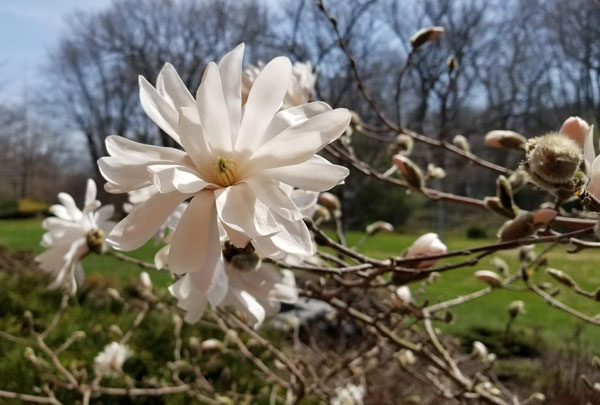Finally, the long-awaited warming of spring has really begun, moving the plant world from a brisk walk to a jog. As I stroll through the gardens at home, I see daily changes in perennial shoots, buds bursting, leaves unfurling, and flowers reflecting the joyous sunshine.
 Today at a client’s in Saint John, a quintessential spring sun-lover had opened some of its amazing large white-petaled flowers in the mid-day sun. The sun is of course a star itself, and this spring beauty is aptly named star magnolia. As I worked nearby for a few hours, I saw many of its fat buds, blushed with pink, unfurl their floppy white petals, revealing soft yellow floral parts in their centers. These exotic beauties are 4-5” in diameter, and create a bold impression against the still-leafless skeleton of the tree.
Today at a client’s in Saint John, a quintessential spring sun-lover had opened some of its amazing large white-petaled flowers in the mid-day sun. The sun is of course a star itself, and this spring beauty is aptly named star magnolia. As I worked nearby for a few hours, I saw many of its fat buds, blushed with pink, unfurl their floppy white petals, revealing soft yellow floral parts in their centers. These exotic beauties are 4-5” in diameter, and create a bold impression against the still-leafless skeleton of the tree.
Some of you with star magnolias less open than this individual might wonder why it is this far advanced. That can be explained by microclimate. I planted it only five feet from the brown-stained wood siding, facing south, with shelter from cold winter winds, and intense solar heat, both incoming, and reflected from the warm siding. It is so obvious the effect of that reflected heat when you look at this magnolia as its buds are just opening. Those closest to the house are fully open, yet on the other side further away, they are still closed. Just 30’ away, there is another star magnolia in a wide open bed, on a north-facing slope, and it is a week or two from opening yet.
You should at least consider the effects of microclimate when locating certain trees, shrubs and perennials, those with 5b or warmer tolerance (for Saint John) and 5a or warmer for Moncton. The coldest microclimates around your home are generally facing west, and especially northwest, where the strongest and coldest winter winds come from. Any windswept spot can be colder than the rest of the lot, especially at building corners, or gaps between large objects where the wind funnels through. There the protective winter snow cover blows off, so the root systems of plants get colder than if covered by insulating snow. Even the twigs get cooled and sometimes dried out by constant wind, more so than in sheltered spots, which can cause flower buds to die, or leaf buds and sections of twig to winter-kill. The broad-leaved evergreens such as rhododendrons and hollies are more susceptible to harsh windy microclimates, as are less cold-hardy deciduous plants like blue hydrangea, butterfly bush, and many Japanese maples. Use common sense in locating less hardy individuals- there is usually a sheltered spot where they can do fine.
Magnolia is one genus I am ever more impressed with after every year of gardening experience… their cold-tolerance, deer-proofness (a new noun I just had to create, not yet in Encarta), compact stature for comfortable placement in many garden beds, and freedom from insects and disease. Add to that the striking beauty of the magnificent flowers, and you arrive at a must-have small tree for every garden.
At our garden center, we have offered a five year guarantee on our trees for years, and I bet we replace 10 flowering crabs and hawthorns for every one magnolia. I could take a moment to enlighten you on some of the problems you may be experiencing with those other two kinds of flowering trees. Don’t get me wrong… I am always blown away by the dazzling display of hot pink many crabs put on in late May, well worth the challenges they come with. Deer would be one. Either buy a crab 8’ tall or more, so they can’t eat the upper branches, or protect it with chicken wire until it grows above their reach. Watch for pencil-size holes within 12” of the ground- evidence of apple borers girdling the trunk, which either stunts or kills the tree. Wet ground causes stunted growth. Poor sunlight reduces bloom show. Whipper snippers and dog chains girdle bark and kill trees. Tent caterpillars make a mess, but not actually permanent damage in most cases. And leaves turn brown and dry in August, falling prematurely due to apple scab, a common native fungus. Pretty crabby, eh? Hawthorns have all the same potential problems, plus are a bit less winter-hardy, and often experience bark-kill from winter cold and stress.
Another small flowering tree that I recommend just as highly as magnolia, and for most of the same reasons, is ivory silk tree, which is in the lilac genus, but a single-stemmed tree-form species. The flowers appear later, after the green foliage is fully formed in mid-June, and are fragrant tall cone-shaped trusses of white, covering the tree for two weeks or so in an attractive display.
One final thought about the landscape use of any of these small trees. They are fine planted singly in the lawn if you prefer, but I find they look better, and grow better in raised garden beds, with smaller shrubs and perennials around them.
